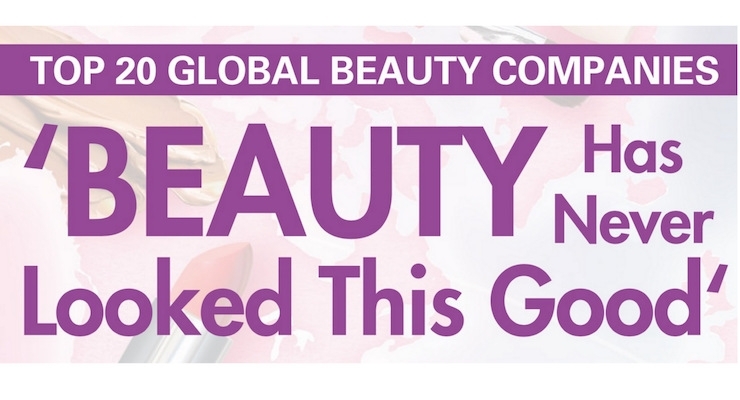Jamie Matusow, Editor-in-Chief, with , Joanna Cosgrove, Contributing Editor11.06.18
Update: See our latest report and rankings—Top 20 Global Beauty Companies 2020
Perhaps there is no better way to lead off our 2018 Top 20 Global Beauty Companies report than with the title quote from Jean-Paul Agon, chairman and CEO, L’Oréal: “Beauty has never looked this good.”
It is particularly telling because the French-owned powerhouse once again achieved the No. 1 slot on our annual list for Fiscal Year 2018 (2017 net sales). Not only did the company retain its position, but sales for the year jumped by $4 billion, an amount higher than the annual total of some of the companies on the lower part of our list.
And L’Oréal wasn’t alone in its enviable figures: In fact, about half of our Top 20 also succeeded in racking up additional billions in sales including The Estée Lauder Companies, Unilever and Coty.
And indeed, the future for the industry seems bright. As Beauty Packaging has reported previously, the latest figures from Orbis Research show that the global cosmetic products market is growing and is expected to reach a value of $805.61 billion by 2023.
According to L’Oréal, the global beauty market grew 4-5% in 2017, in part due to a resurgence in skincare. Cosmetic industry sales, in general, remain driven by the luxury consumer market, in particular affluent U.S. and Chinese consumers, both at home, online and through travel retail.
A growing Chinese market—with cosmetics sales in China forecast to exceed $40 billion by 2021, surpassing the U.S. as the world’s biggest market for makeup and skin care, according to Euromonitor International—as well as strategic Indie brand purchases by Loréal, The Estée Lauder Companies and Unilever, led to overall annual success.
Going Green
With concern about climate change and pollution becoming more of an issue, especially among Millennial consumers, brands have been more active than ever in searching for solutions to potential packaging waste. At the start of 2018, many of our Top 20 made headlines with announcements of new sustainable packaging initiatives.
The EU revealed a plan that would make all plastic packaging within the bloc recyclable, reduce single-use plastic and restrict microplastics. A number of companies committed to 100% reusable, recyclable or compostable packaging by 2025 and set targets for using post-consumer recycled content.
In addition, consumers are also looking for a pledge for societal good on the part of brands—and many of our Top 20 have issued reports that reflect these types of efforts. In April, for example, P&G announced the launch of Ambition 2030, a package of broad, forward-looking goals that aim to “enable and inspire positive impact on the environment and society while creating value for the company and consumers.” In addition to responsible consumption through the use of 100% recyclable/reusable packaging, the company also specified the importance of responsible and sustainable business practices, and noted that it had embedded human rights and environmental policies into its supply chain.
As influential Chinese consumers ramp up their eco-consciousness, packaging, manufacturing and transparency are taking top priority in Asia and beyond.
The timing certainly seems right for Natura & Co, with its focus on eco-friendly packaging and clean formulations—as well as efforts to benefit society via its corporate philosophy. In No. 18 position on this year’s Top 20 list, the Brazil-based brand is making a bigger splash in the global market—accessing “green” brands, opening retail stores in the U.S. and, according to rumors, even making a recent bid for Avon.
What Lies Ahead
Technology, consumer behavior, changing demographics… While “beauty has never looked so good,” uncertainties remain—and an increasingly targeted focus on digitalization, e-commerce and supply chain (and an eye on tariffs), continues to keep all involved constantly on their toes. As Unilever’s CEO Paul Polman stated: “…our industry experienced unprecedented levels of disruption last year, driven by the accelerating pace of technology. When combined with significant changes in consumer behavior, these events are causing manufacturers and retailers alike to rethink fundamentally how they reach, serve and—ultimately—delight consumers in markets that are more dynamic and open to entry than ever before.”
Report Data
Just a note on the compilation of this report: Companies were analyzed based on 2017 data. Beauty sales included only cosmetics, fragrance and personal care items when possible. Figures for companies outside the U.S. were based on the exchange rate for the fiscal year on the day it ended. Estimates are provided in cases where full disclosure was not available.
Top 20 Global Beauty Companies
Click on each for a detailed review of each company -- its brands, acquisitions, and more.
1. L’Oréal $31.2 billion
2. Unilever $24.8 billion
3. Estée Lauder $13.7 billion
4. Procter & Gamble $12.4 billion
5. Coty $9.4 billion
6. Shiseido $8.9 billion
7. Beiersdorf $6.9 billion
8. LVMH $6.7 billion
9. Johnson & Johnson $6.1 billion
10. Amorepacific $5.6 billion
11. Kao $5.2 billion
12. Henkel $4.7 billion
13. Avon $4.2 billion
14. L Brands $4.2 billion (est.)
15. Mary Kay $3.5 billion (est.)
16. Chanel $3.2 billion (est.)
17. Colgate-Palmolive $2.9 billion
18. Natura & Co $2.9 billion
19. Revlon $2.7 billion
20. Kose $1.7 billion




























